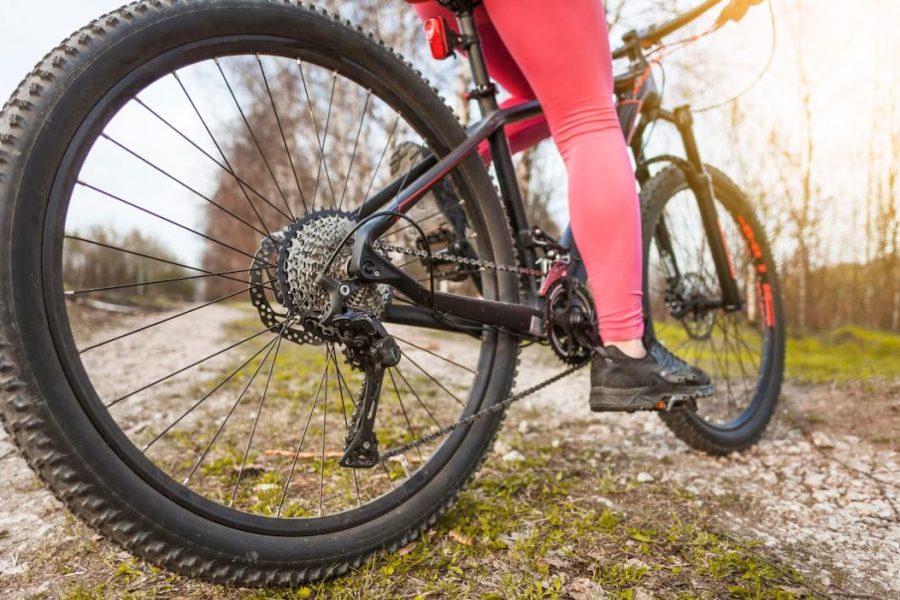Fat tire bikes have recently become a popular choice for those looking to explore the great outdoors. While regular bikes are typically designed with thinner tires, fat tire bikes feature larger, wider tires that offer more traction and stability.
This article will explore the advantages of riding fat tire bikes on flat surfaces as well as common issues associated with them and how to increase pedaling efficiency.
Key Takeaways
- Fat tire bikes require more effort to pedal on flat surfaces compared to regular bikes.
- Adjusting gear ratio, maintaining proper tire pressure, and utilizing a smooth pedal stroke can increase pedaling efficiency on fat tire bikes.
- Riding fat tire bikes on flat surfaces provides benefits such as improved weight distribution, increased tire pressure for better traction, enhanced shock absorption, and more powerful pedaling force.
- Common issues with fat tire bikes on flat surfaces include less efficiency on hard-packed dirt or pavement, the need for more effort to pedal, difficulty in maneuvering due to added weight, and challenges with mud traction.
The Advantages of Fat Tire Bikes
Fat tire bikes are known to provide an increased level of stability, traction, and comfort compared to traditional bicycles. These benefits extend to riding through varied weather conditions and varying terrain due to the larger contact patch that the tires provide.
Additionally, fat tire bikes can be ridden at lower tire pressure which further increases traction on slippery surfaces. This makes them ideal for those who desire freedom from restrictions such as difficult terrain or extreme weather conditions.
The Difference Between Fat Tire Bikes and Regular Bikes
Comparison of the design features between fat-tire bikes and regular bicycles may explain the differences in pedaling difficulty across a flat surface.
Fat tire bikes are designed with larger, wider tires that provide more traction and stability while riding on challenging terrain such as mud, sand, or snow.
On the other hand, regular bicycles typically have thinner tires which usually make them easier to pedal over flat surfaces.
Additionally, fat tire bikes generally have higher gear ratios which can assist with hill climbings but also make them tougher to pedal on flatter ground.
As a result, fat tire bikes may require more effort when pedaling even on flat surfaces compared to traditional bicycles.
How to Increase Pedaling Efficiency on Fat Tire Bikes
Riding a fat tire bike can be more strenuous than cycling on a traditional bicycle, particularly on flat surfaces, so there are techniques one can use to increase pedaling efficiency.
Adjusting the gear ratio and maintaining proper tire pressure are two key methods for optimizing performance. A higher gear ratio allows the rider to pedal at faster speeds with less effort while lower pressure tires provide greater traction and shock absorption.
Furthermore, proper technique is important; utilizing a smooth pedal stroke will maximize output while conserving energy.
Adopting these measures will help improve comfort and speed as well as minimize fatigue over long rides.
The Benefits of Riding Fat Tire Bikes on Flat Surfaces
Cycling on fat tire bikes offers a number of advantages over traditional bicycles when traversing flat surfaces. These include:
- Improved weight distribution, making it easier to ride with greater stability
- Increased tire pressure for better traction and grip
- Enhanced shock absorption to reduce rider fatigue
- More powerful pedaling force for increased speed.
This allows riders to experience the freedom of cycling with greater ease, comfort, and enjoyment on flat surfaces than ever before.
Common Issues With Fat Tire Bikes on Flat Surfaces
In flat surfaces, the use of fat tire bicycles can bring certain challenges. Mud traction and frame design are two common issues.
The wide tires on fat bikes make them less efficient at rolling over hard-packed dirt or pavement than a narrower tire, as they require more effort to pedal. Additionally, the added weight of the bike’s frame design can be difficult to maneuver up hills or even coasting downhill.
To counteract these issues, riders must take extra care to adjust their bike’s settings accordingly for better performance in all terrains.
Frequently Asked Questions
What Types of Terrain Are Best Suited for Fat Tire Bikes?
Fat tire bikes are best suited for rough terrain, uneven surfaces, and safety concerns. They provide greater stability on unpredictable terrain while allowing riders to experience freedom of movement and a smooth ride.
Are Fat Tire Bikes More Expensive Than Regular Bikes?
Fat tire bikes are typically more expensive than regular bicycles due to their specialized design and features such as increased safety, stability, and traction. However, the cost of a fat tire bike is worth it for those who need better performance on rougher terrain.
What Is the Weight Difference Between Fat Tire Bikes and Regular Bikes?
Fat tire bikes typically have wider tires than regular bikes, increasing rolling resistance and overall weight. On average, fat tire bikes weigh around 10-20 pounds more than regular bikes. This additional weight can make pedaling more difficult on flat surfaces.
How Do Fat Tire Bikes Compare to Mountain Bikes?
Fat tire bikes and mountain bikes differ in safety considerations, suspension, and geometry. Fat tire bikes are designed for use on soft terrain with more traction and stability than other bike types. Mountain bikes provide more suspension to absorb the bumps of rough terrain, allowing for greater freedom of movement when riding. Both offer riders unique experiences that must be considered before deciding which type of bike is best suited for their needs.
Are Fat Tire Bikes Suitable for Long-Distance Cycling?
Fat tire bikes are suitable for long-distance cycling due to their improved road comfort and lower tire wear. With wider tires, fat tire bikes provide a smoother ride than more traditional road bikes, while the increased traction on wet surfaces further enhances stability. Thus, riders can enjoy confident rides over longer distances with minimal fatigue.
Conclusion
Fat tire bikes provide riders with a unique biking experience due to their wide tires, which can offer more stability on uneven terrain and provide better traction in difficult conditions.
On flat surfaces, fat tire bikes require more effort to pedal due to the extra rolling resistance of their larger tires. However, by using lower gear ratios and proper technique, riders can maximize the efficiency of their pedaling efforts when riding fat tire bikes on flat surfaces.
Ultimately, the advantages associated with riding fat tire bikes on flat surfaces outweigh any slight increase in effort required for pedaling.








